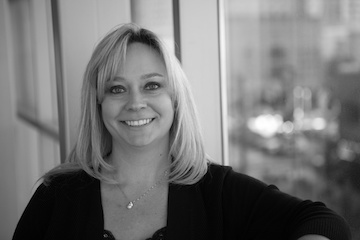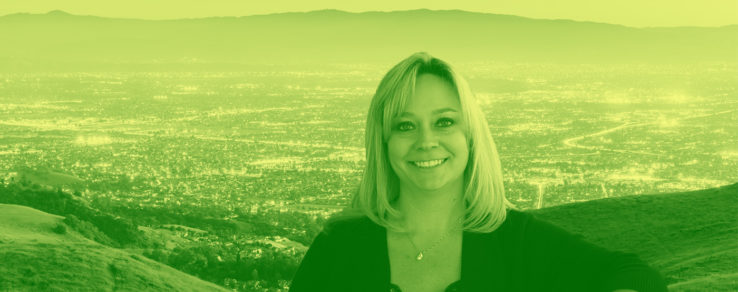After 27 years at Silicon Valley Power, Mary Medeiros McEnroe has experienced some major changes in California’s utility landscape. Throughout her career, she has made it her mission to help customers every step of the way.
Medeiros McEnroe worked with business customers to prevent rolling blackouts during the Western U.S. energy crisis of 2000 and 2001. Later that decade, she helped launch the utility’s first social media accounts. More recently, she provided proactive communications to prepare customers for the possibility of Public Safety Power Shutoffs, a safety procedure that turns off power in the case of wildfires and other natural disasters. Now, as Public Benefits Program Manager, Medeiros McEnroe makes a positive impact on residents and local businesses in Santa Clara through energy efficiency programs.
A big part of her job is building relationships with business customers, trade allies and other community partners. To learn more about the needs of customers, specifically larger C&I companies, Silicon Valley Power holds energy task force meetings at least once per year. According to Medeiros McEnroe, these conversations are essential to better serve businesses.

“Customers aren’t shy about providing feedback,” Medeiros McEnroe says. “We survey them after participation in our programs to gather information on what’s working and what isn’t. We also talk to contractors and trade allies and see what they’re hearing from customers, especially in areas where we aren’t getting a lot of participation.”
Medeiros McEnroe also focuses on building relationships with third party companies that work with local businesses to achieve energy efficiency goals. For example, Efficiency Services Group proposed an external lighting program that would provide fixtures to area businesses free of charge — the businesses were only responsible for the installation cost. Initially, there were a few business customers who didn’t have the resources to move forward with the installation. Much to the surprise of Medeiros McEnroe, Efficiency Services Group worked on several projects at no cost to the customer to ensure these businesses could take advantage of the program.
“They were really invested in our community and wanted to have a positive impact,” Medeiros McEnroe explains. “The fact that we had this relationship and they felt a tie to our community is what made this happen. That’s why it’s so important to develop relationships with those who are serving your customers.”
During the coronavirus pandemic, Medeiros McEnroe helped create an energy efficiency program to ease the financial burden for struggling small businesses in the utility’s service territory. She designed and launched the utility’s Energy Efficiency Grant Program for Small Businesses to help fund energy efficiency upgrades. Silicon Valley Power committed $1 million to the program, which launched in the summer of 2020.
“I get a lot of job satisfaction with being able to help customers, even if it’s just one customer,” Medeiros McEnroe says. “I had phone conversations with some of the program participants and they shared with me what they had been going through during the pandemic. It meant a lot to hear how thankful they were for the program and how much it helped their business.”
When she’s not making a positive impact on local businesses, you’ll find Medeiros McEnroe on an airplane, both as a passenger and pilot. In 2017, she received her private pilot’s certificate. Combining her two passions of flying and giving back, Medeiros McEnroe volunteers with Pilots N Paws, a nonprofit that assists with animal transportation. She transports dogs in need to foster and forever homes across California.
Questline Digital spoke with Medeiros McEnroe to get her views on changes in the utility industry, creating successful energy efficiency programs and building relationships with business customers.
How did you get started in the energy utility industry?
This was an accidental career for me. I worked in the utility billing department in customer service while in college and decided to stay on as I went through an MBA program to obtain my master’s degree. My master’s thesis project was to write a strategic plan for an organization, and I selected our municipal electric utility because I had access to people at lunch and could run ideas by them. This was at the time that California was getting ready to launch deregulation and the industry was changing quickly.
Following my master’s program, I moved into an account management role at the utility. In 2007, I made the move to managing our energy programs and working on the outreach for these programs, as well as managing the utility’s social media accounts.
What has changed the most about your job working in the utility industry over the course of your career?
I’ve held four different roles within the utility, but all have been focused on helping customers in one way or another. I’ve been through the energy crisis in California that resulted in rolling blackouts and economic downturn, as well as the dot-com bust that resulted in a lot of vacancies. At that point, my role turned toward economic development and bringing new businesses into the city.
When I moved into managing programs, we ran energy efficiency, renewable energy, low income and R&D programs. With changes in legislation, that has expanded into building and transportation electrification programs as well. Legislative changes have also resulted in a lot more state-mandated reporting and other requirements.
In California, we are also now facing wildfire issues and system constraints during peak days, which has brought about Public Safety Power Shutoffs (PSPS) and brought back rotating outages. While our customers haven’t been impacted by the PSPS events, it has brought about a lot of communication via social media to explain what is happening as the state or region is impacted by events that may not impact our customers. Social media has really grown for us as a great way to have two-way dialogue with our customers, especially during a power outage.
What excites you the most about the energy utility space?
This is an exciting time to be working in the electric industry. Throughout my 27 years, the industry has been constantly changing. When I was in high school and my early college years, I never would have considered the energy industry as the place I would end up, but I’m glad it worked out this way. We constantly get to work on new things, especially at a small municipal utility where we each can wear many hats. That variety keeps things interesting. I also love being able to help customers. Designing and implementing programs that truly make a difference to our customers is really fulfilling.
What campaign or initiative are you most proud of?
When the pandemic hit, it really impacted our small business community and I wanted to find a way that we could help. I came up with the idea to offer an energy efficiency grant up to $10,000 for small businesses impacted by the mandate to close or significantly reduce their operations. We were able to pull this together and launch it in just a few months and then began extensive outreach. We did a direct mail postcard, direct mail flyer, social media campaign and ads on our local cable channel, along with door-to-door outreach. We also trained our trade ally contractors on the program and provided them with marketing materials.
My goal for the program was to reduce the ongoing costs of small businesses through energy efficiency as well as help to support the contractors in continuing to work and avoiding layoffs. We need those contractors to be there for our programs in the future, so it was important to support not only the local businesses, but also those who serve them through our programs. We recently won an award for this program through the California Municipal Utilities Association.
What is the hardest part of working in the energy industry today?
The hardest part of working in the energy industry today is keeping up with all the changes that are happening. There is so much to monitor now — changes to legislation and regulation, reporting requirements, emerging technologies, new program ideas, ways to use data analytics, etc. There are so many opportunities out there and with a small staff, we can’t do everything we would like to do. We have to prioritize what would have the biggest benefits to our customers and the utility and what will help the city meet its Climate Action Plan goals.
Finish this sentence: If I weren’t working in the utility industry, I would be…
If money were no object and I didn’t have to worry about paying the bills, I would love to do something that involves travel. I love seeing the world and experiencing new places and cultures. Perhaps I would be a travel blogger or lead small tour groups through foreign countries to see the highlights and explore some of the off-the-beaten-path places.
I also love to fly and have my private pilot certificate. I love sharing the experience with people and taking them up for their first flight in a small plane. It would be fun to operate “flightseeing” tours of beautiful places, like the San Francisco Bay or up in the Pacific Northwest. I’m considering a seaplane rating in the future, so maybe you’ll find me operating a charter for backcountry flights to remote areas where we can land on lakes.
How do you anticipate the world of energy evolving in the coming years?
I think the pace of change is going to continue to get faster and the lines between traditional utilities and third parties will continue to blur. From a program standpoint, we will continue to have a focus on energy efficiency and renewable energy programs, but we will increase our efforts around building and transportation electrification, energy storage and microgrids.
We need to continue to find ways to work with customers to meet their needs as they adopt new technologies and strive to achieve their own sustainability goals. We also will be working toward reducing greenhouse gas emissions and addressing constraints on transmission, distribution and generation resources. I’m looking forward to all the opportunities these challenges bring to allow us to try new things and develop new programs. Change is what has kept my career in the utility industry interesting for so many years!
What advice would you give to those entering the utility space?
I would advise people entering the industry to remember that although utilities are mostly regulated, we still need to think of customers as if they have a choice. This means designing our programs and services with their needs in mind. We need to find ways to work with them to provide the programs and services that they need while balancing the impacts on our utility grid and other customers.
I’d advise people entering the industry to be open to thinking outside the box and partnering with customers and third parties on pilot projects and programs. I would also advise everyone in the industry to try new things and be willing to fail. We learn something with each failure and can then take what we learned to create something even better.

